CW82 July, 2023
Renovation of the major gymnasium

The renovation of the 34-year-old major gymnasium will start on October 1 (Sun). The main and sub arenas and judo-kendo training room will be air-conditioned, rest rooms and the elevator will be repaired and/or improved, and lighting fixtures will be replaced with LED bulbs. In addition, deteriorated facilities and equipment will be mended or replaced. During the renovation works, the gymnasium will be closed.
The works will take a year and a half. For the period, Hamamina, private companies as well as elementary, junior high, and high schools will be used for temporary training facilities.
For the other gymnasium in Umeda, which is going to be opened as usual during the period, another basketball court is planned. The court will be adjustable so that elementary school children will be able to play on it.
Toyoko Inn is to start its business in late July
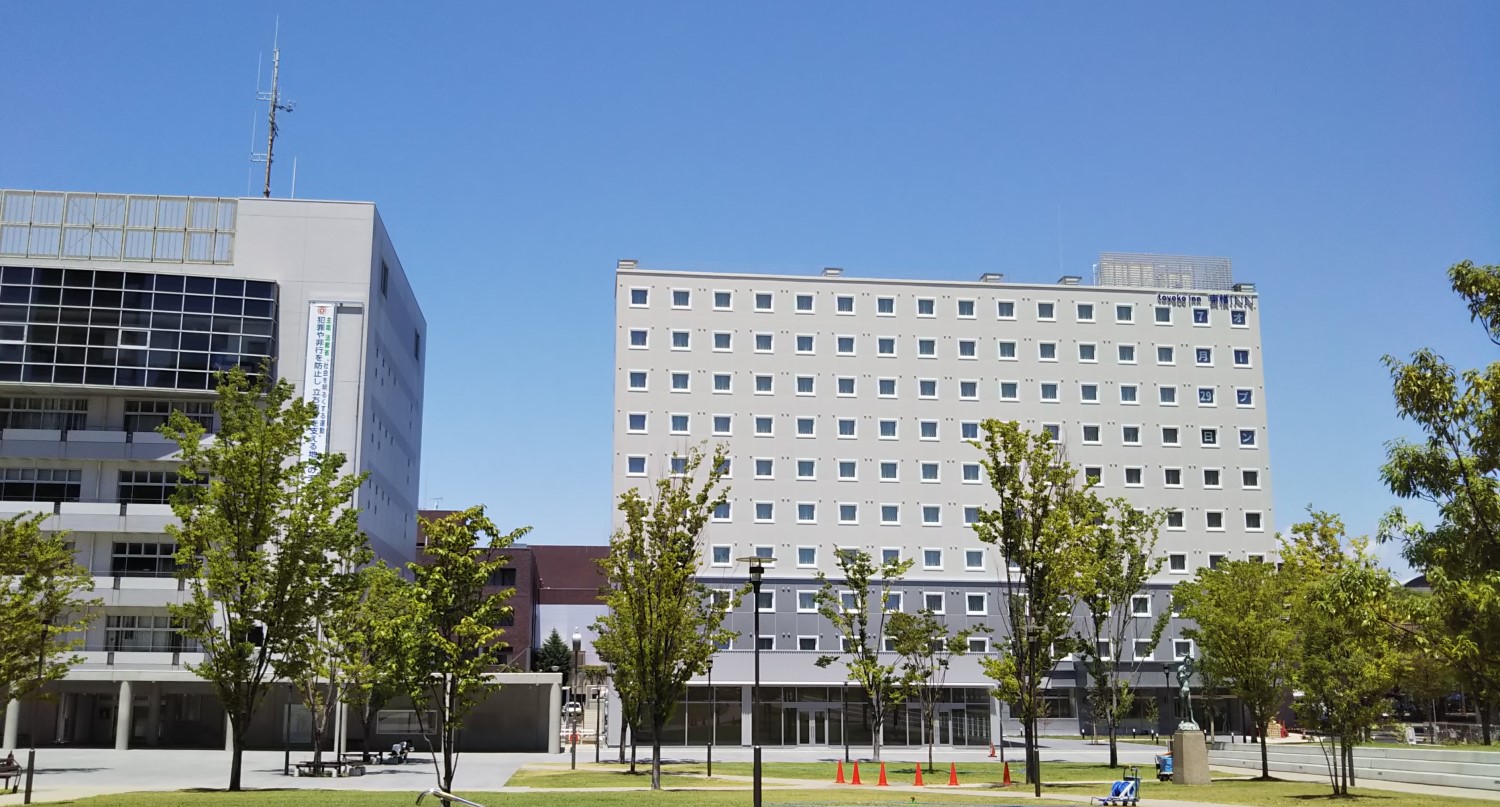
Toyoko Inn on the site of City Hall’s former temporary offices is going to start its business on July 29 (Sat). The 10-story building has 249 rooms. The construction of the inn is aimed at utilizing the municipal land to secure a new source of income as well as to activate and to bustle the City Hall district.
Chigasaki FM will start broadcasting on October 10
The local FM station, Chigasaki FM, or the nickname “EBOSHI RADIO STATION”, will be located in the Toyoko Inn building and operated by Chigasaki City Tourism Association. It will provide information on Chigasaki, including tourist spots, specialties and festivals as well as disaster prevention and everyday life. It will also offer music and other entertainments.
About 2,230,000 tourists visited Chigasaki in 2022, 130,000 up from a year earlier
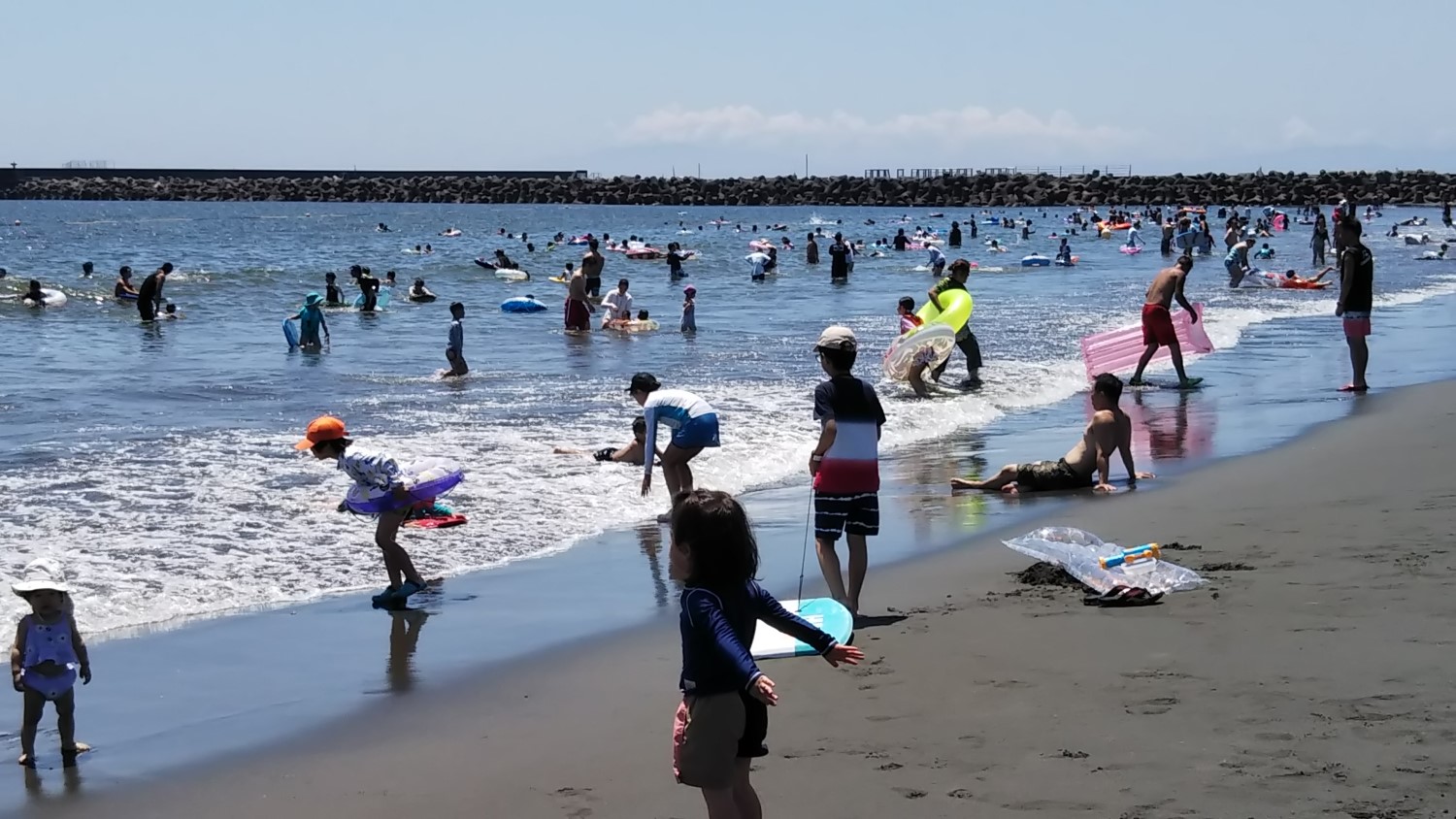
The city office reported in June that Chigasaki attracted 2,230,000 tourists in 2022, up 6.4% from the previous year. Although Ooka Echizen, Shonan and Hamaori Festivals among four major festivals were canceled due to COVID-19, many events on the beach, including Aloha Market and the firework display, contributed to attracting more visitors.
On July 23 (Sun), about 70% of the parking spaces near the Southern Beach were occupied. The beach was moderately crowded, and visitors were enjoying swimming and sunbathing in a peaceful atmosphere, which may be Chigasaki’s strong point compared to the beaches of other cities.

The numbers of visitors to Chigasaki, Fujisawa and Kamakura for the past five years are shown in the table above. Three cities are apparently on a recovery trend in terms of the numbers of visitors. Both Fujisawa and Kamakura attracted far more people than Chigasaki, because the two cities are blessed with abundant tourist resources. The michi-no-eki in Yanagishima, which will be completed in two years, is expected to call people in Yamanashi, Nagano and other inland areas to Chigasaki.
Flowers of the season: Cotton rose mallow
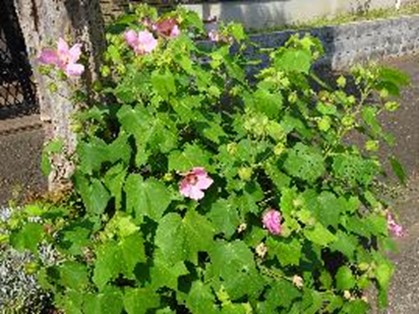
As Cotton rose mallow and Rose of Sharon are members of the Malvaceae family, they are similar to each other in their blossoms and blooming periods (from July to October), but they are easily differentiated based on the forms of trees and leaves. The former branches crosswise, and extends horizontally. It has alternate leaves and each leaf, 8-20 cm wide and about 10 cm long, is like a palm in shape, splitting three to seven. Its surface is covered with white fuzz. The latter extends vertically and forms a tree taller than is wide with smaller and dark green leaves.
Blossoms of Cotton rose mallow have curled pistils whose stigmas split into five. Meanwhile, Rose of Sharon’s blossoms have straight pistils and their tips do not separate. Blossoms of the two varieties have transient lives. They bloom in the morning and wither away in the evening, but blossoms keep blooming one after another until autumn.

Cotton rose mallow, which is half-hardy, grows naturally in China, Taiwan and western Japan. Its blossoms, having five petals about 10-15 cm in diameter, are originally white and pink.
However, Hibiscus mutabilis, another member of the Malvaceae family, is well known as a garden variety. Its Japanese name is ‘Suifuyou’ (酔芙蓉), which means a drunken Cotton rose. Its double blossom is pure white color when it starts blooming in the morning, but with dusk approaching, the pure white turns into pink to red.
On the southern island called Koshiki-shima in Kagoshima prefecture, traditional Japanese clothes named ‘Be-danashi’ are preserved in the local history and folk museum. They were made in the Edo or Meiji Era from the bark of Cotton rose mallow trunks. The bark was soaked in running water for a month to take out the softest layer and then, it was turned into yarn from which the clothes were weaved. The breathable clothes are cool, and wealthy families wore them as festive kimono.
History of Chigasaki: Murota Village (2)
On the north of the shinden, magusaba, or a field, was marked on the map. The field was to grow grass which was used as fertilizer in the Edo period. 皇国地誌 (the topography by the Meiji government) says the area of the field is 7,820 square meters.
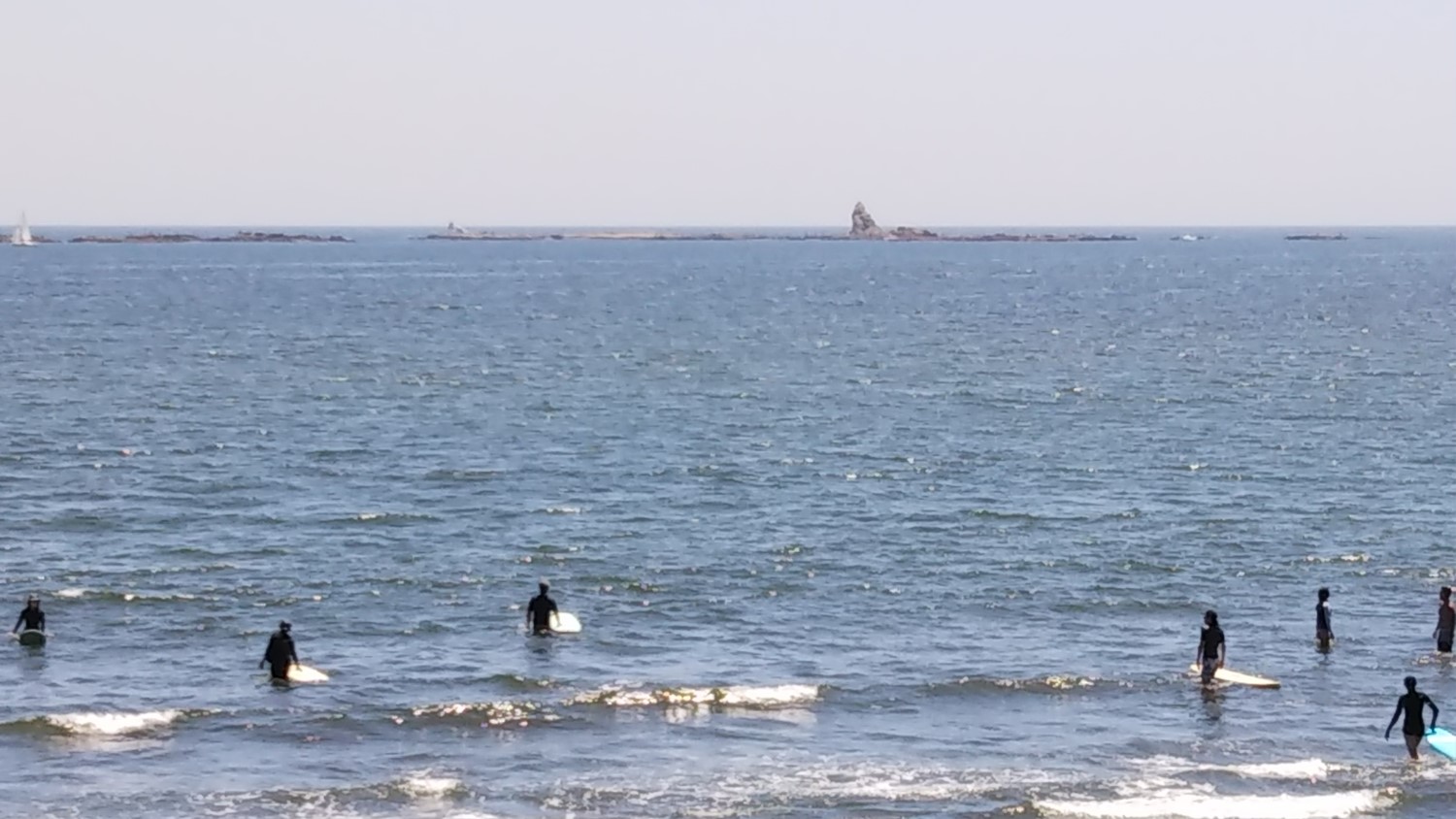
Chigasaki and Kowada Villages argued over fishing rights in the fishing grounds off the coast in 1663. The next year, the shogunate decided that the line connecting the Teshiro mound and the Eboshi rock, the largest rock of the Ubajima islands, would be the border. Today, Rachien Street runs along the line. However, there isn’t the Teshiro mound on the map, and if the line is extended to the north, it reaches the main building of Myokoji Temple. And there is a memorial mound for the dead person’s soul on the east of the temple instead. The mound list in the City History (III) describes that the Teshiro mound was located at Teshirozuka 831, a corner in today’s Shorin 3-chome. But the line connecting the corner and the Eboshi rock do not match Rachien Street. It is unclear where the Teshiro mound was in around 1663.
The main hall of Hachioji Shrine is built with a hip-and-gable roof construction (Irimoya style) and has a Chinese styled gable (kara hafu) and long eaves in front. The dignified architecture is a characteristic of the late Edo period. The building was originally the shrine of the residence of Hinoya, a wealthy merchant in Ichinomiya (Samukawa), but it was moved to the current place in 1881. There are two basins at the foot of the stone steps in front of the building*. On the larger basin, following words are inscribed: 龍 (ryu), or a dragon; 日夜心 温水 (nichi ya shin, onsui), or day, night and heart, and warm water; 正四位 山岡鉄太郎 書 (sei-shi-I Yamaoka Tetsutaro sho), or the fourth rank, Yamaoka Tetsutaro wrote. The stone was donated to the shrine by a Yasohachi Suzuki in Uraga, today’s Yokosuka city. The Suzuki was a fishmonger and regularly visited the Yamaoka family in Uraga to take orders. He obtained the calligraphy from the family, and then he gave it to the Yamaoka family in Murota, and they had the words inscribed on the stone.
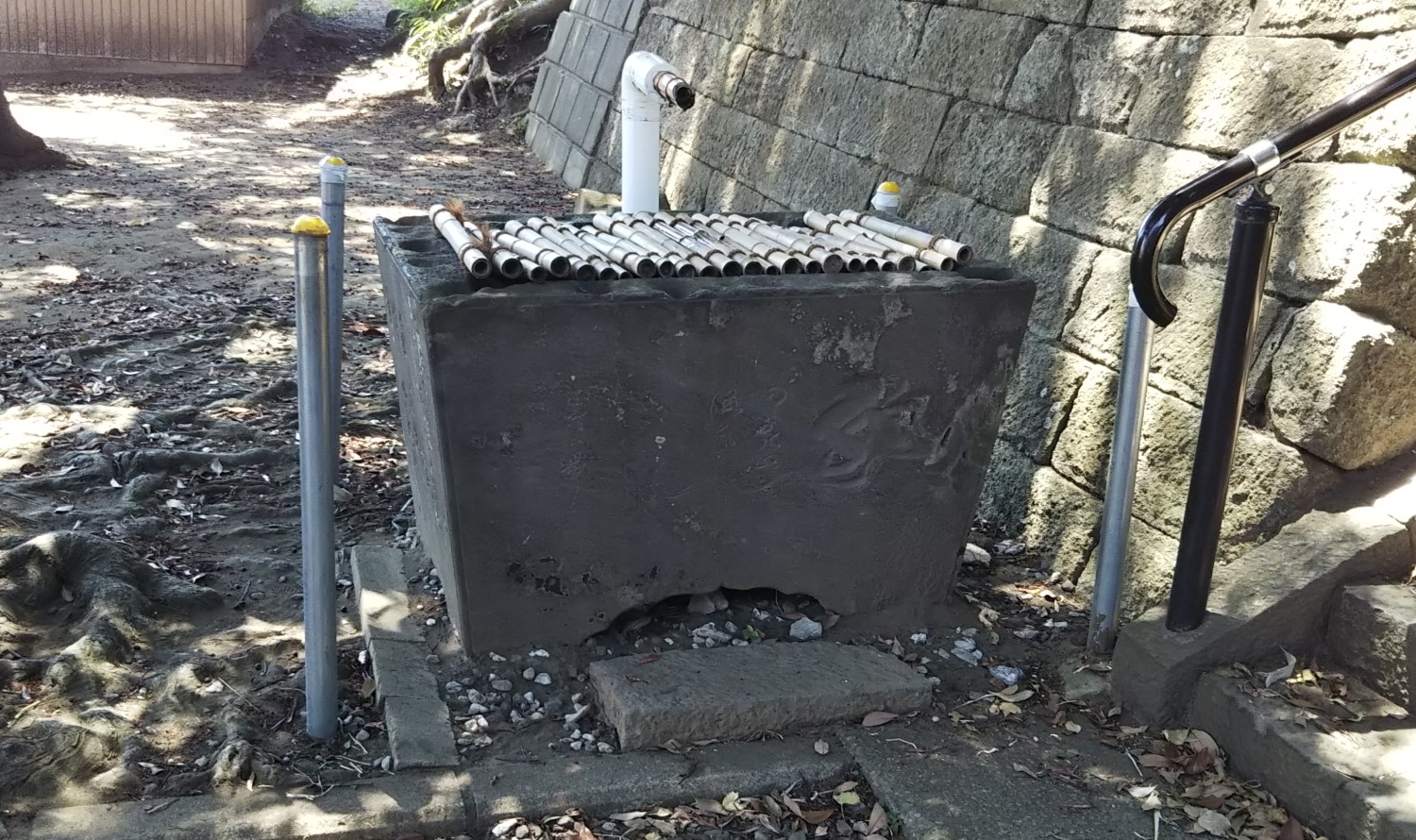
*There was only one basin at the foot of the steps. See the photo above. Inscriptions of the words 龍, 日夜心, and others were not observed.
Interested in Japanese proverbs?
1) 有為転変は世の習い (UI TENPEN WA YO NO NARAI)
UI means phenomena happening due to various causes, TENPEN everything is changing, WA to be, YO the world, NO of, and NARAI the way.
Nothing is permanent in the human world. Life is full of vicissitudes. If you visit your home town in summer holidays for the first time in several years, you will find subtle or apparent changes there. You may see a deserted shopping arcade near your house and a big supermarket in the suburbs. Some of your old friends may have left for other cities.
Your shool days never return. The past is in the past. Thus, make the most of today to have a better tomorrow.
The saying is in 柏崎(謡曲), or Noh chant “Kashiwazaki”, a tragic story about a family in Today’s Kashiwazaki city in Niigata prefecture. It was made in the Muromachi era (1392 - 1573).
Its English equivalents are:●All worldly things are transitory.
●Life is full of ups and downs.
●There is change of all things.
2) 鬼も十八、番茶も出花 (ONI MO JUHACHI, BANCHA MO DEBANA)
ONI means an ogress, MO too, JUHACHI 18 years old, BANCHA coarse tea leaves, MO too, and DEBANA fresh tea.
Even an ogress looks pretty at eighteen. Tea leaves of low quality gives off aroma just after hot water is poured into the teapot. Even a homely girl changes into a pretty girl as she grows older. Wearing her best kimono, she surprises others by her grace and brightness on Coming-of-Age Day. She has become an attractive young woman.
The proverb also says people, not only girls but also boys, will have compassion and consideration for others by the time they are 18.
The saying is in 毛吹草, or Kefuki-gusa, an anthology of haiku, published in 1645. As a necessary book at haiku gatherings, it went through many editions.
Its English equivalents are:
●Good timing is essential to everything.
●There is a time and place for everything
●The devil was handsome when he was young.
Invitation to Kamakura (33) – Hydrangeas (Bimonthly serial)
The rainy season has come again. The humid and damp weather continuing intermittently for several weeks will definitely make us feel gloomy. But it might not be so bad if we notice that there is refinement only to be seen in this season: colorful hydrangeas shining in the rain.
It is said that there are over 2,000 species of hydrangeas in the world. Their original species is Hydrangea macrophylla, which much to our joy is native to Japan, and whose habitats are on the Boso, Miura and Izu Peninsulas. This species has become naturalized in China, Korea, Siberia, New Zealand, the Americas and Europe. The story that Philipp Franz von Siebold (1796 -1866), a German doctor and botanist, studied the flora of Japan during his stay at Dejima, Nagasaki (1823-1829) as a medical officer of the Dutch East Company is well known. He introduced the Hydrangea macrophylla and other Japanese plants to Europe. After that, new varieties were developed for ornamental purposes in Europe, and they were brought back to Japan. Now we can see them everywhere on street corners and in temple gardens, in parallel with the original one.
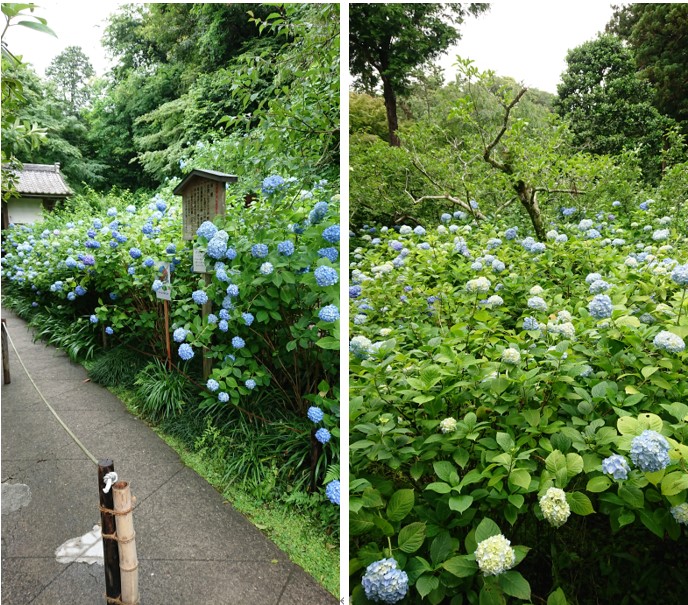
There are many temples renowned for their hydrangeas in Kamakura. Meigetsuin Temple known as Hydrangea Temple is the best spot among them. Each side of trails, which branch off like a maze and lead up to the temple, is blanketed with more than 2,500 hydrangea shrubs bearing abundant flower heads. Fully bloomed Princess Hydrangeas radiate brilliant blue dubbed Meigetsuin blue.
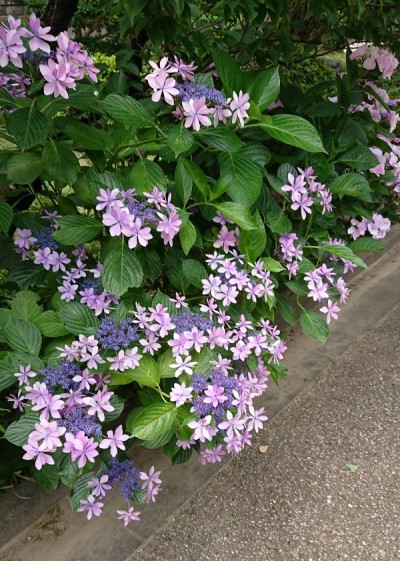
Hase-dera Temple is another top visited site. The scenery of over 40 kinds of 2,500 hydrangeas extended over the hillside is stunning. Viewing the vividly colored, round clusters of flowers, we can look down at Kamakura city and Sagami Bay from the top of the hill. Jochiji Temple offers fewer hydrangea flowers in number compared to the above temples, but hydrangeas in the precinct create a unique atmosphere, harmonizing with its historical building and the mountain silence.
The photo on the left was taken at Kencho-ji Temple
Hydrangeas flaunt a variety of colors – white, blue, red, pink, light and dark purple. The colors except white are affected by the pH in soil and produce pigment for each color.
Annual opening event of Kanagawa Prefectural Institute of Public Health
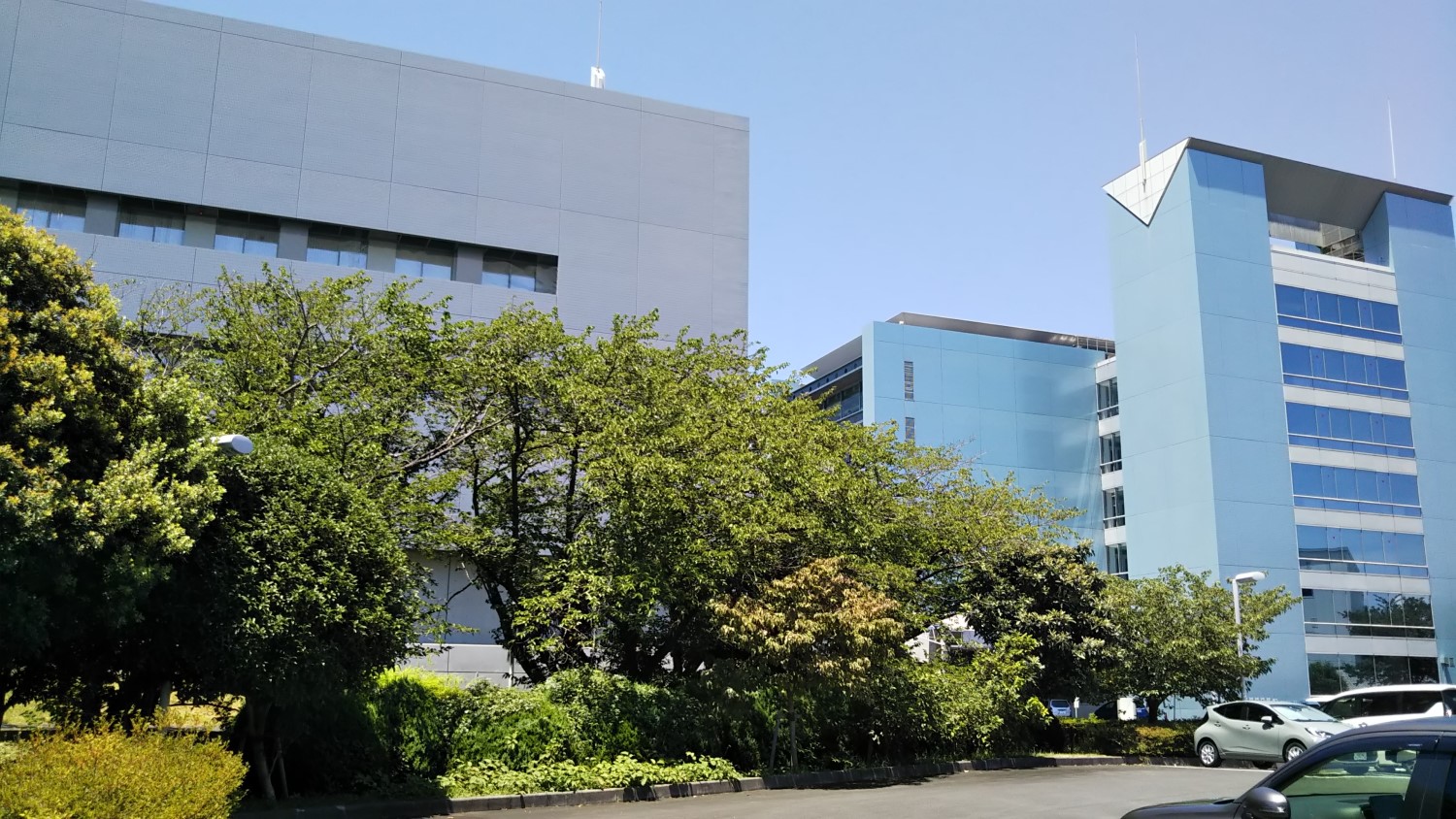
The annual opening event of the institute, in Shimo-machiya, took place on July 25 (Tue) from 9:30 to 15:30. A lecture about the new coronavirus, a laboratory tour, and experiments were major events.
A microbiologist lectured about microorganisms and the new coronavirus. He said seven varieties of the new coronavirus have been found so far, and 80% of the latest coronavirus has been Omicron XBB in Japan. The variety especially infects people at 70 and older so that elderly people should receive vaccinations, according to him. After the lecture, a school girl asked him what school she should go to become a microbiologist. The reporter sincerely hopes she will realize her dream.
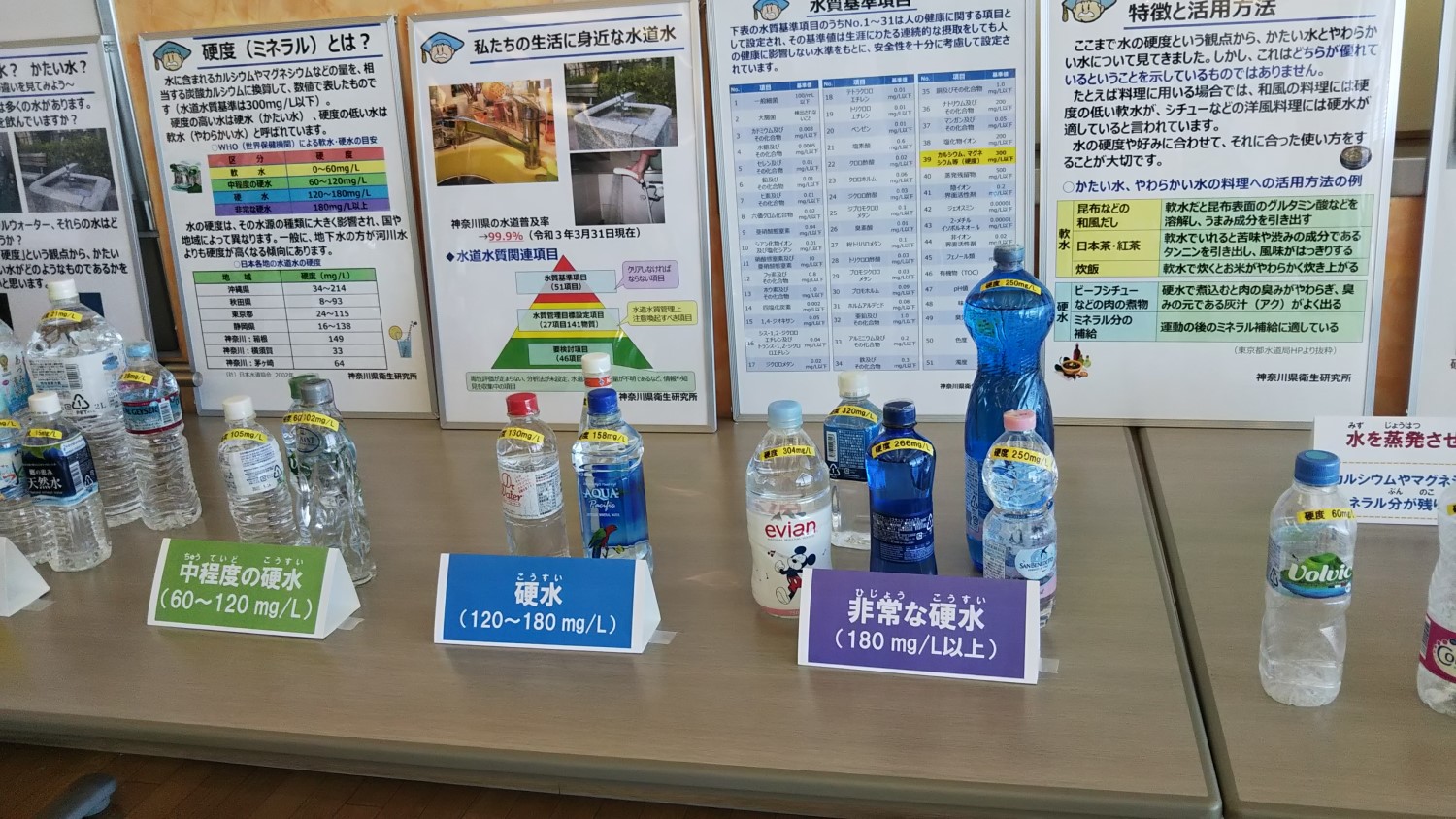
In the experimental room, the determination of sugar concentrations in various drinks, the effect of water hardness on the stability of soap solutions, the extraction of DNA from a banana, and three other experiments attracted visitors. The reporter was surprised to find that bottles of water with extremely high hardness (>1000 ppm) are on the market as healthy drinks. We should know that fruit juices contain more sugar than sports drinks and sweet tea.
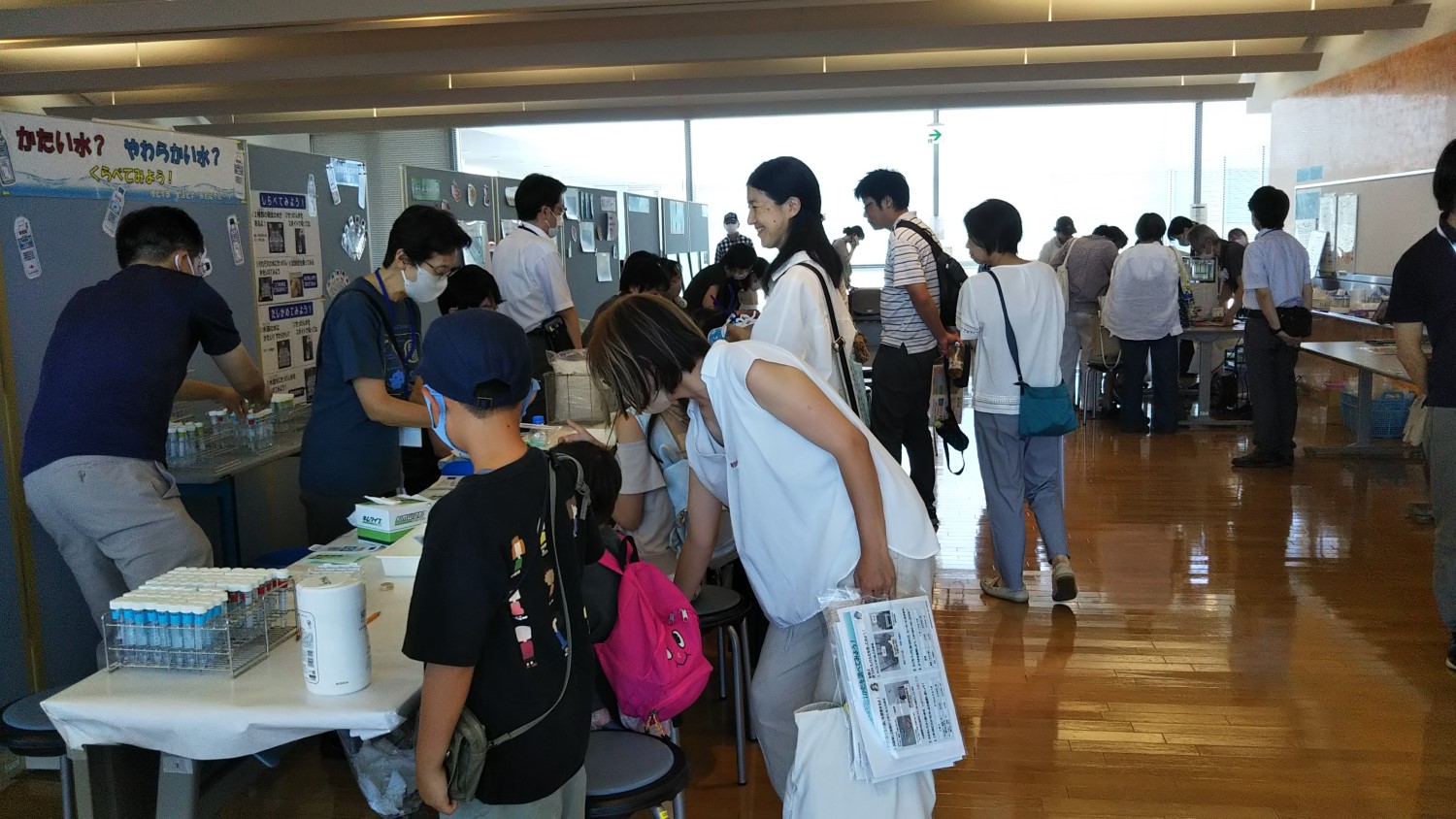
The experimental room was crowded with school children and their mothers. They probably got tips for independent research children had been assigned to do during the summer vacation.
Coronavirus pandemic is gaining momentum
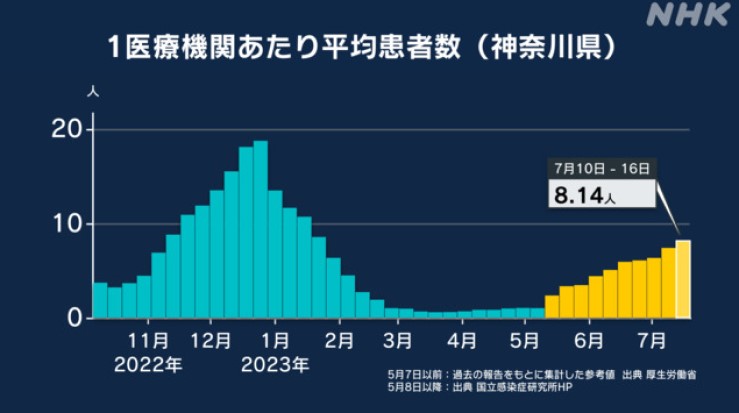
Kanagawa Prefecture reported on July 20 (Thu) that the average number of infected people in the week of July 10 to the 16th was 8.14 per designated hospital, a 0.76 increase from the previous week. The figure has been rising since early May. See the chart above. The total number of inpatients in all the designated hospitals was 762 on July 19, up 138 from the 12th.
The summer holidays having started, experts warned us against the spread of the infectious disease from now on as people will increasingly visit their home towns or tourist spots at home and abroad. A university professor says half of the nation’s population has not suffered the disease yet, and thus the spread of infection is anticipated.
As for vaccination percentages, only 24.4% have received the third booster as of July 23 (Sun), only 0.7% up from the previous month.
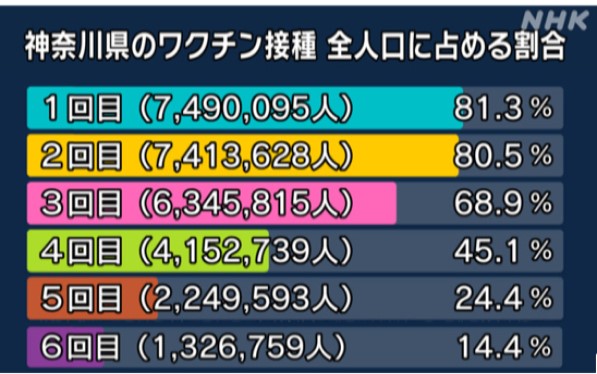
For the average number of patients per designated hospital, go to
https://www3.nhk.or.jp/news/special/coronavirus/data/pref/kanagawa.html
For vaccination percentages, go to
https://www3.nhk.or.jp/news/special/coronavirus/vaccine/pref/kanagawa/
Events in July
Kamakura-bori, lacquerware, exhibition
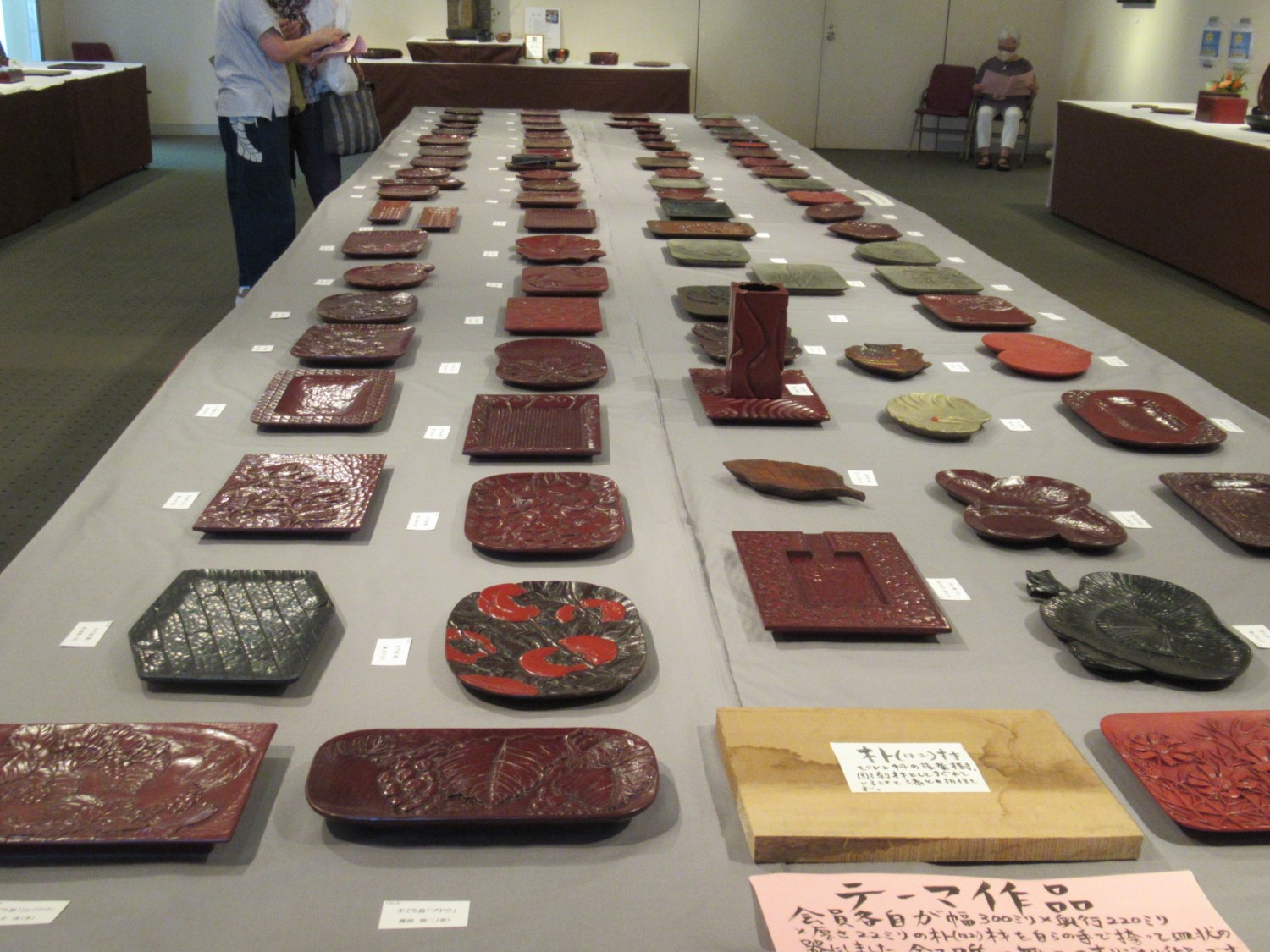
An exhibition of about 200 pieces of Kamakura-bori was attractive. At the exhibition held on July 12 (Wed) to the 16th (Sun) at Citizen Gallery, the lacquerware of various sizes and shapes was mostly made by chiseling hardwood plates about 40 cm long, 30 cm wide and three cm thick, and lacquering them repeatedly. It was the first exhibition by the group, Encho-kai, in six years and commemorated its 35th anniversary.
Encho-kai, led by Toshiki Ozono, who has received the certificate of the great traditional craftsman, is based in Kamakura, and has several classes for Kamakura-bori in Fujisawa, Chigasaki and Tokyo as well as in Kamakura. One of them, the Chigasaki class in the Shorin community hall, has been continuing for 33 years and now 20 members engage in wood carving under the guidance of Ozono for two hours twice a month. A man who has been a member for over ten years said it took several months to complete one work, and said that he could concentrate his attention on his hobby during the coronavirus restriction, which helped him to lead a usual everyday life.
Kamakura-bori is known for its lustrous finish, and hardy and durable characteristics, namely the combination of its beauty and practicality. Its origin can be traced back to 800 years ago when Zen priests in the Chinese Song Dynasty brought fine arts and crafts called Tuishu (堆朱), Buddhist altar fittings, to Japan. The crafts fascinated the then Buddhist statue sculptors and they attempted to acquire the technique by carving and lacquering Japanese wood plates. Those crafts were lacquered traditionally in black and vermilion. However, modern Kamakura-bori shows various different colors and appearances, so that some look like they are made of metals.
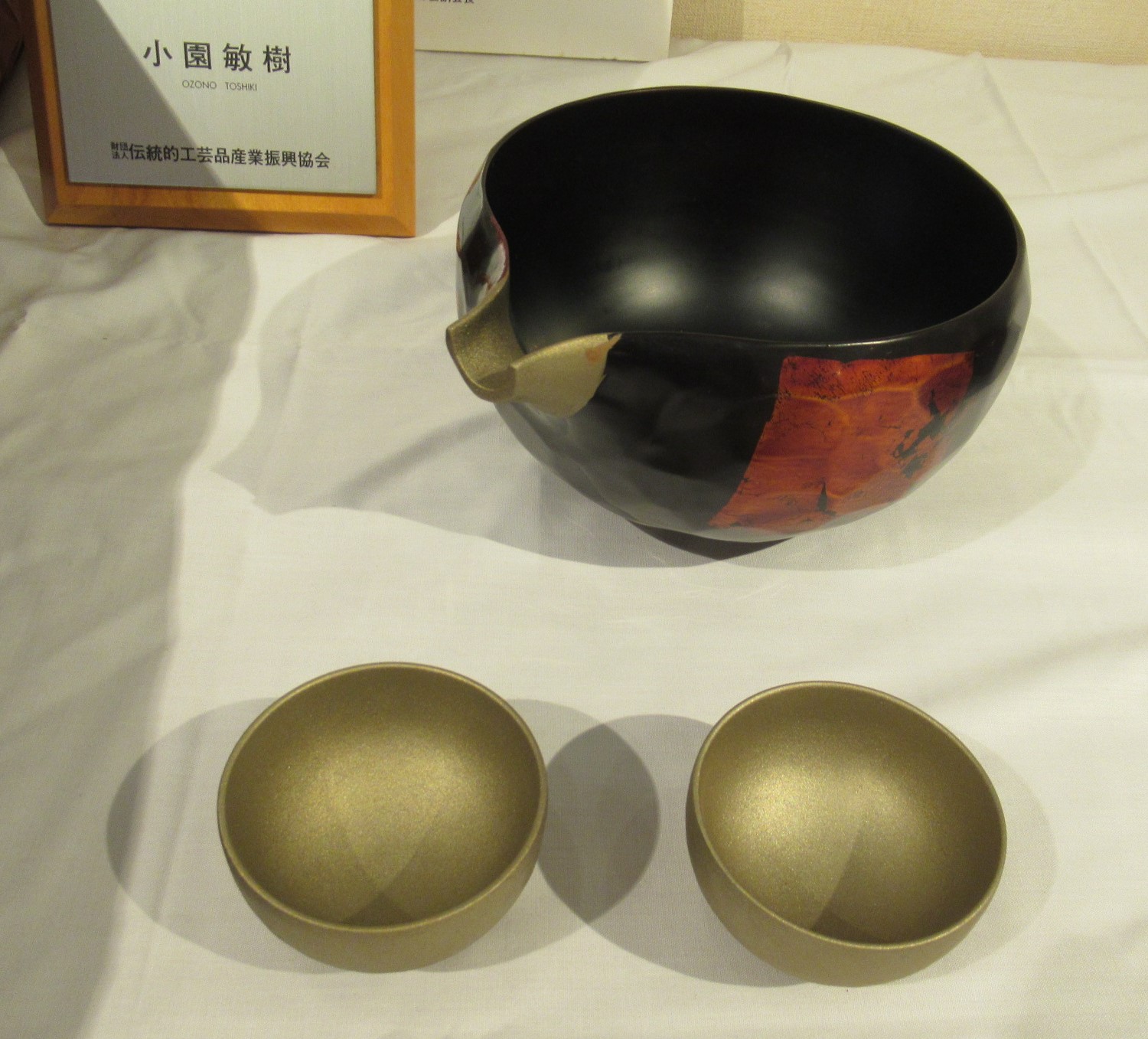
Hamaori Festival 2023
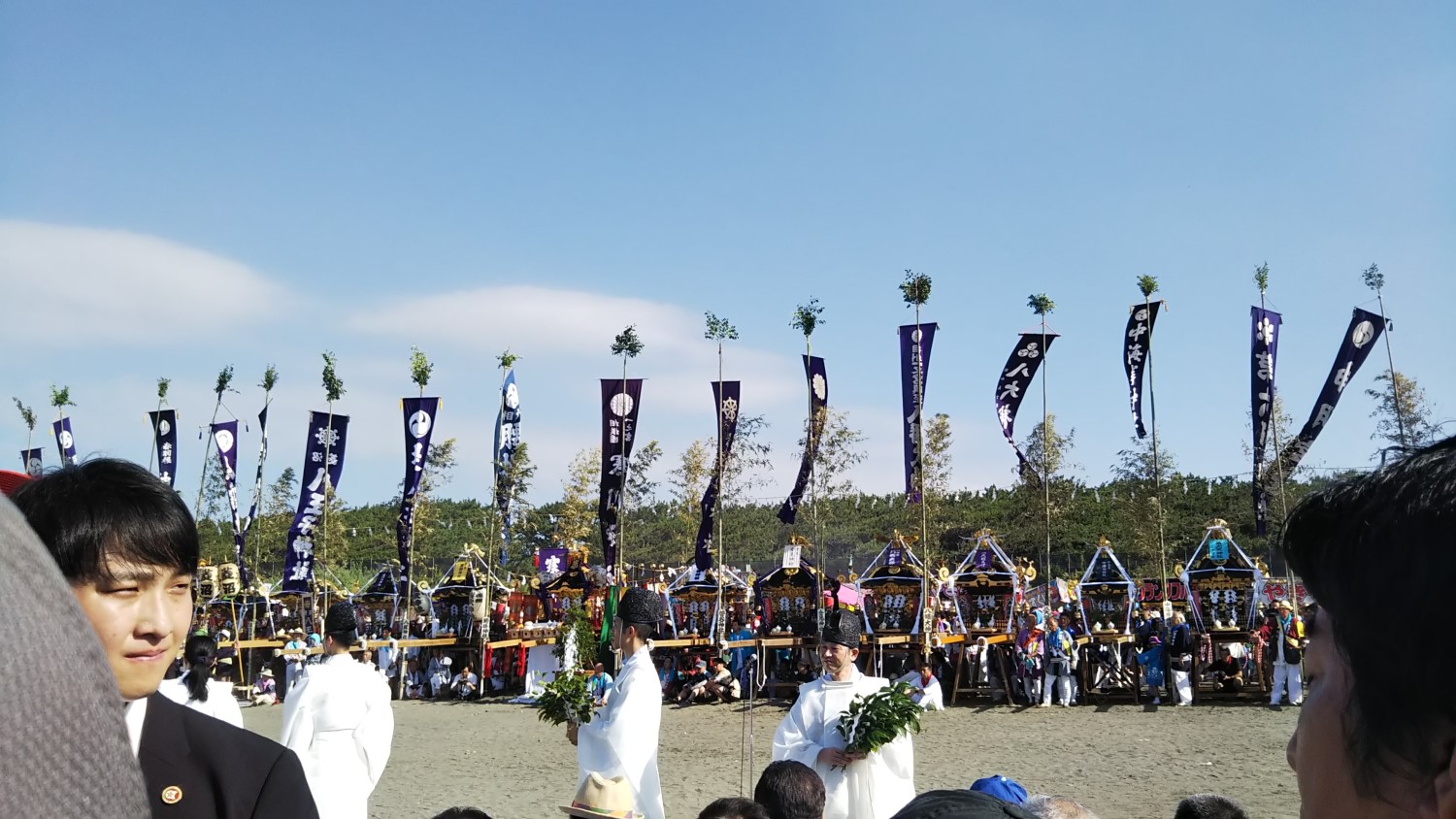
Hamaori Festival, one of the major events of Chigasaki and Samukawa and an intangible cultural asset of Kanagawa, took place on the Nishihama Beach on July 17 (Mon, Marine Day) for the first time in four years. Thirty-nine mikoshi from 34 shrines participated. Blessed with fine weather, the temperature may have exceeded thirty-five degrees Celsius. The first mikoshi reached the beach before dawn. A TV program reported that about 100,000 people visited the beach. Wasn’t it too many?
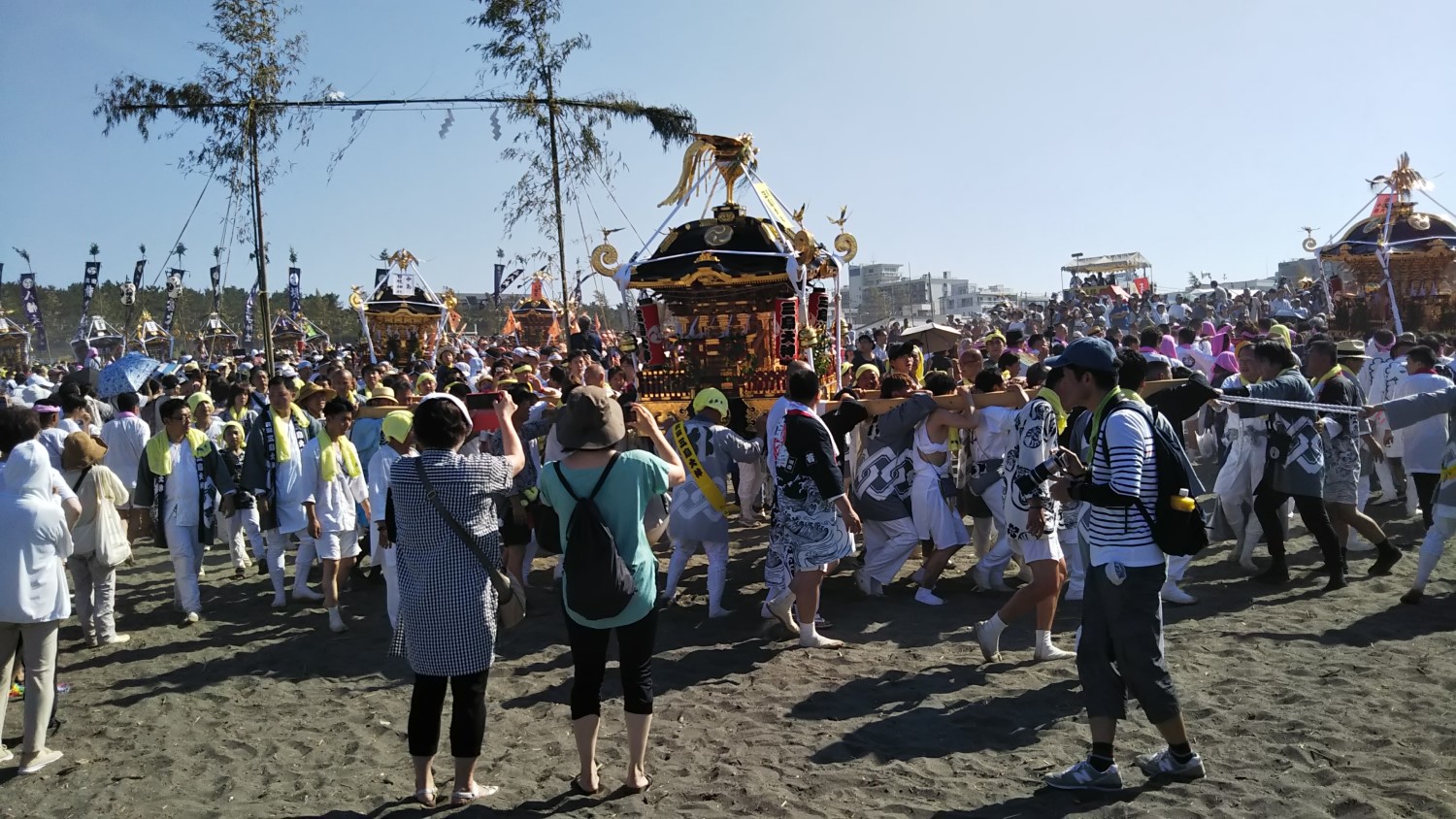
A Shinto ritual was carried out in the square surrounded by a throng of spectators from 7:00 to 8:00 in the morning. The chief priest of Samukawa Shrine prayed for the peace and security of the nation, a bumper crop and large catches.
After the ritual and before they returned to their shrines, some of the mikoshi went into the sea for purification. Most of the spectators came to watch the exciting scene. They felt the real beginning of summer in Chigasaki, and energized a lot.
Events in August
Citizen Gallery on the 4th floor of N’EST-CE PAS Chigasaki
●Photo exhibition “Living creatures in the Shonan area” by Hiroshi Naekawa: August 4 (Fri) 13:00 ~ 17:00, the 5th (Sat) 10:00 ~ 17:00, the 6th (Sun) 10:00 ~ 16:00
●Exhibition of handicrafts, paintings and photos by a grandpa and his friendly company: August 16 (Wed) to the 19th (Sat) 10:00 ~ 17:00, the 20th (Sun) 10:00 ~ 15:00
●The 1st Student Calligraphy exhibition: August 25th (Fri) 13:00 ~ 18:00, the 26th (Sat) 10:00 ~ 18:00, the 27th (Sun) 10:00 ~ 17:00
●Exhibition of calligraphy by Miyoshi-kai Chigasaki: Sept 6 (Wed) 13:00 ~ 17:00, the 7th (Thu) to 9th (Sat) 10:00 ~ 17:00, the 10th (Sun) 10:00 ~ 16:00
Southern Beach Chigasaki Fireworks

The 49th Southern Beach Chigasaki Fireworks is going to take place on August 5 (Sat) 19:30 to 20:10. Skyrockets and underwater-launch fireworks will color the night sky. The firework is supported by many companies, shops and citizens. As a new attempt, pay stands will be set near the breakwater like many municipalities to get money to hold the festival next year and beyond. Tickets for the stands will be sold from 10:00 on the day (for more information, see the city website). About 2,000 fireworks will be launched.
Chigasaki City Museum of Art
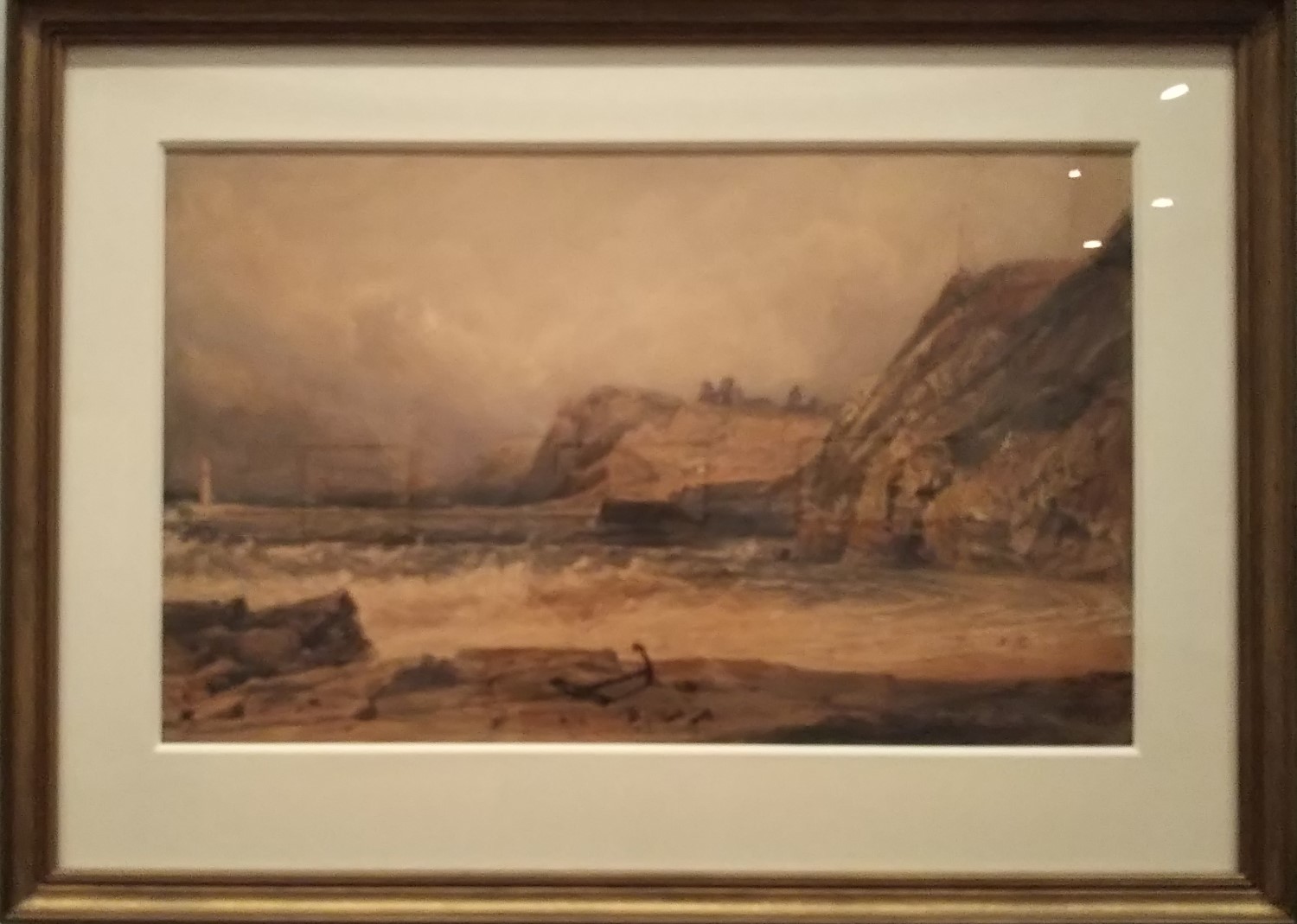
Picture exhibition, “British Landscape and Doppo Kunikida”, is going to be held through August 27 (Sun). Profound works by British artists will show visitors traditional expressions of Western art.
Admission fee (yen): Adult 1,000, Uni. student 800, Citizen aged 65 and older 500, High school student and younger, handicapped person and their caretaker free.